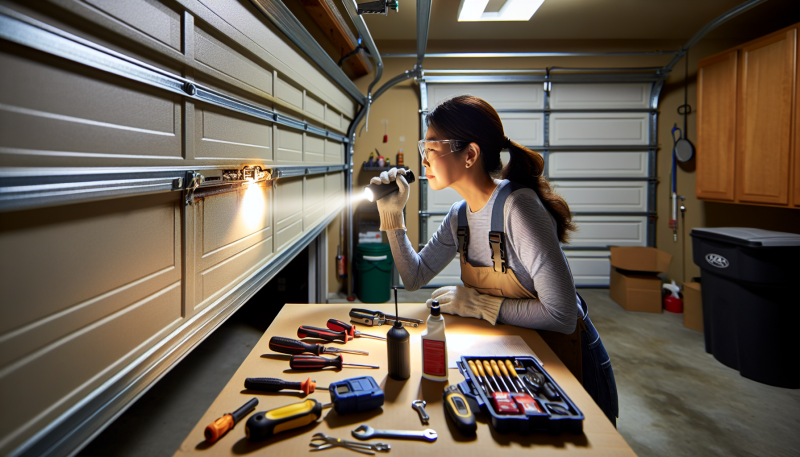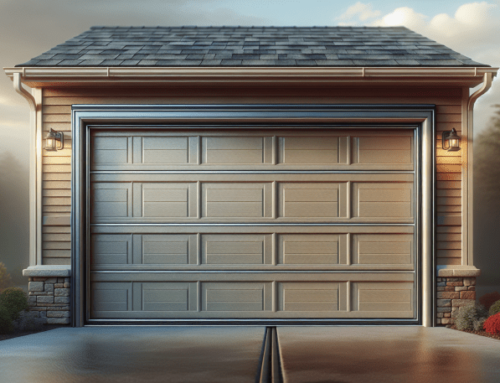**How to Identify Garage Door Problems Early**
Is your garage door making strange noises or not opening smoothly? Identifying garage door problems early can save you time, money, and frustration. Regular maintenance and keen observation can help you catch issues before they escalate, ensuring your garage door operates safely and efficiently.
Common signs of garage door problems include unusual sounds, slow operation, and misalignment. For instance, if you notice your door hesitating or sticking, it could indicate a need for lubrication or a more serious mechanical issue. By staying vigilant and addressing these signs promptly, you can avoid costly repairs and extend the lifespan of your garage door.
But these are just a few indicators of potential problems. To help you navigate the complexities of garage door maintenance, we’ll explore expert tips and insights that can empower you to take action. Let’s dive into the essential steps for identifying and resolving garage door issues before they become major headaches.
Understanding the Importance of Early Problem Identification
Identifying garage door problems early is essential for ensuring safety and maintaining functionality. A malfunctioning garage door can pose serious risks, including accidents that may lead to injuries. For instance, a door that suddenly closes can cause harm to pets or children. Additionally, ignoring minor issues often leads to more significant, costly repairs down the line.
Statistics reveal that nearly 20,000 injuries occur annually due to garage door accidents. This alarming figure underscores the need for proactive maintenance. Regular inspections can help catch problems before they escalate. For example, worn-out springs can lead to a complete failure of the door mechanism.
Moreover, addressing issues promptly can save homeowners money. A small repair today can prevent a larger expense tomorrow. Therefore, staying vigilant about garage door health is not just about convenience; it’s about protecting your home and loved ones. For more information on maintenance, visit our services page or learn about our expertise. If you have questions, feel free to check our FAQ section.
Common Garage Door Problems
Garage doors often encounter several issues that can disrupt their functionality. Misalignment is a common problem. When the door doesn’t open or close smoothly, it may be off track. Look for gaps between the door and the frame as a clear sign of misalignment.
Another frequent issue involves broken springs. These springs bear the weight of the door, and when they fail, the door may become heavy or impossible to lift. If you hear a loud bang or notice the door sagging, it’s time to inspect the springs.
Malfunctioning openers can also cause significant headaches. If the remote control fails to work or the door doesn’t respond, the opener may need repair or replacement. Check for blinking lights on the opener, which can indicate a problem.
For a deeper understanding of these mechanics, consider visual aids or diagrams. They can clarify how each component functions. Addressing these issues early can save you from costly repairs. For more information, visit our service page or learn about frequently asked questions.
Visual Inspection Techniques
Performing a visual inspection of your garage door is essential for early problem detection. Start by examining the door panels for any dents or cracks. Look closely at the edges and corners, as these areas often show signs of wear. Next, inspect the hinges and rollers for rust or damage. If you notice any corrosion, it may indicate a need for replacement.
Check the weather stripping along the bottom of the door. Worn or cracked weather stripping can lead to energy loss and water intrusion. Additionally, observe the tracks on either side of the door. Ensure they are free from debris and aligned properly. Misalignment can cause operational issues.
For a thorough inspection, consider using a flashlight to illuminate dark areas. A ladder may also be helpful for reaching higher components. Lastly, listen for unusual noises during operation. Any grinding or squeaking sounds could signal underlying problems. Regular inspections can prevent costly repairs down the line. For more information on maintenance, visit our about page or check our FAQ section.
Listening for Unusual Noises
Listening to your garage door during operation can reveal significant insights into its condition. Unusual sounds often indicate underlying issues that require attention. For instance, a grinding noise may suggest that the rollers or tracks need lubrication. Squeaking sounds often point to worn-out hinges or a lack of proper maintenance. Meanwhile, banging noises could indicate loose hardware or a misaligned door, which can lead to more severe problems if not addressed promptly.
To effectively document these sounds, consider keeping a log of when they occur and the specific noises you hear. This record can help you identify patterns and determine if the issue worsens over time. Additionally, you might want to record the sounds using your smartphone. This way, you can share the audio with a professional for a more accurate diagnosis. Regularly monitoring these noises can save you from costly repairs down the line. For more information on maintenance, check out our FAQ section or learn about our services. If you need assistance, feel free to contact us.
Testing the Garage Door Mechanism
To ensure your garage door operates smoothly, start by testing the garage door opener. First, press the remote or wall switch to open and close the door. Observe its movement for any unusual sounds or jerks. Next, check the safety features. Place a small object, like a piece of wood, in the door’s path. The door should automatically reverse upon contact. If it doesn’t, the auto-reverse mechanism may need adjustment or repair.
Additionally, inspect the sensors located near the bottom of the door. Ensure they are clean and aligned properly. Misaligned sensors can prevent the door from functioning correctly. Regular testing is crucial for ongoing functionality. Aim to perform these checks every month. This proactive approach helps identify potential issues early, saving you from costly repairs later.
For more information on maintenance and repairs, visit our services page. If you have further questions, check our FAQ section. Remember, a well-maintained garage door enhances safety and convenience.
Recognizing Signs of Wear and Tear
Garage doors consist of several components that experience wear and tear over time. Key parts include rollers, tracks, and cables. Rollers can become worn, leading to noisy operation or difficulty in opening and closing. Inspect them regularly for cracks or chips. Tracks may accumulate dirt or debris, causing misalignment. Ensure they are clean and free of obstructions. Cables are crucial for lifting the door; frayed or broken cables can pose serious safety risks.
To assess the condition of these components, use this checklist:
- Examine rollers for signs of wear.
- Check tracks for dirt or damage.
- Inspect cables for fraying or breaks.
- Listen for unusual noises during operation.
- Test the door’s balance by manually lifting it halfway.
For maintenance, lubricate rollers and tracks with a silicone-based spray. Replace any worn components promptly to avoid further damage. If you notice significant issues, consider professional help. For expert assistance, visit our service page. Regular checks can extend the life of your garage door and enhance its performance. For more information, check our about page.
When to Call a Professional
When dealing with garage door issues, knowing when to seek professional help is crucial. Complex repairs, such as those involving the motor or electrical components, often require expert knowledge. Additionally, if you notice unusual noises or if the door operates erratically, it’s wise to call a professional. Safety concerns, like a door that suddenly drops or fails to open, should never be ignored.
Choosing a reputable garage door repair service can make all the difference. Look for companies with positive reviews and a solid track record. Verify their credentials and ensure they are licensed and insured. This step protects you from potential liabilities.
While DIY repairs may seem tempting, they often lead to more significant problems. Professional maintenance not only ensures safety but also extends the lifespan of your garage door. Experts can identify underlying issues that you might overlook. For reliable service, consider visiting our service page or learn more about our about us section. Ultimately, investing in professional help can save you time and money in the long run.
Preventative Maintenance Tips
To ensure your garage door operates smoothly, regular maintenance is essential. Start by inspecting the door’s hardware, including hinges, rollers, and tracks. Tighten any loose screws or bolts to prevent further issues. Next, clean the tracks and remove debris that could obstruct movement. Lubrication plays a crucial role; apply a silicone-based lubricant to the rollers and hinges to reduce friction.
Create a seasonal maintenance checklist to stay organized. In spring, check for rust and clean the door’s surface. Summer is ideal for inspecting the opener and testing safety features. During fall, examine weather stripping for wear and replace it if necessary. Finally, winter is the perfect time to ensure the door operates smoothly in cold temperatures.
Regular inspections help identify potential problems early. By maintaining your garage door, you can extend its lifespan and avoid costly repairs. For more information on services or to learn about garage door types, visit our website. Remember, a little effort goes a long way in preserving your garage door’s functionality.
Frequently Asked Questions (FAQs)
When it comes to garage door issues, many homeowners have similar concerns. One common question is, "How often should I inspect my garage door?" Regular inspections every six months can help catch problems early. Additionally, you might wonder, "What are the signs of a failing garage door opener?" Look for unusual noises, slow response times, or failure to open or close completely. These can indicate a need for repair.
Another frequent inquiry is, "Can I fix a garage door myself?" While some minor issues can be addressed independently, it’s wise to consult professionals for complex problems. For instance, if you encounter broken springs, consider reaching out to experts for garage door spring repair.
Lastly, many ask, "What should I do if my garage door is off track?" In such cases, avoid using the door and contact a repair service immediately. For more detailed information, visit our FAQ section or explore our blog for tips on maintenance and repairs.
Conclusion and Summary of Key Points
In summary, identifying garage door problems early is crucial for maintaining safety and functionality. Regular inspections can reveal issues before they escalate, saving you time and money. Pay attention to unusual noises, slow operation, or misalignment, as these can indicate underlying problems. Additionally, routine maintenance enhances the lifespan of your garage door, ensuring it operates smoothly.
Taking proactive steps not only safeguards your investment but also protects your home and family. If you notice any signs of trouble, don’t hesitate to seek professional help. Timely repairs can prevent costly damage and enhance your garage door’s performance. For more information on services available, visit our service page. Remember, a well-maintained garage door contributes to your home’s overall safety and efficiency. For further insights, check our FAQ section. Ultimately, staying informed and vigilant will empower you to take action when necessary, ensuring your garage door remains in optimal condition.






